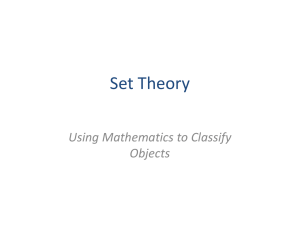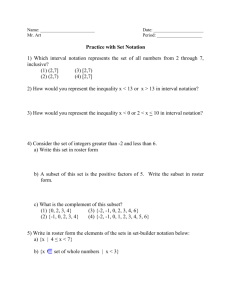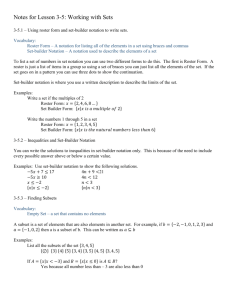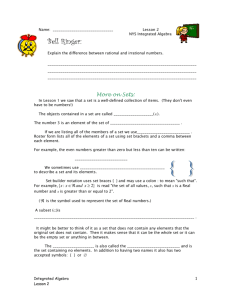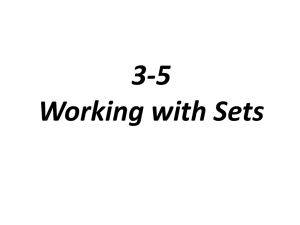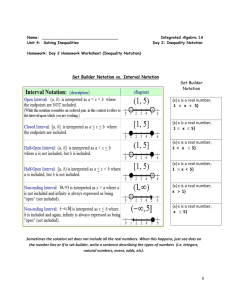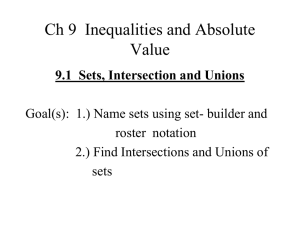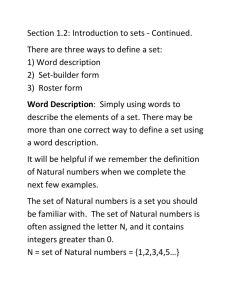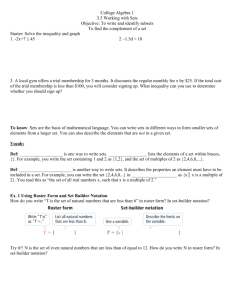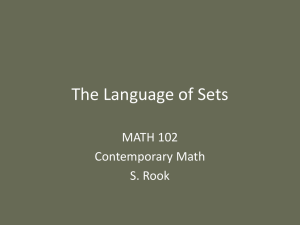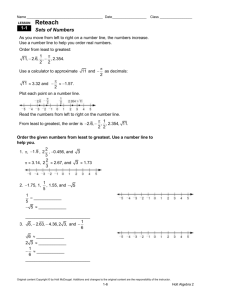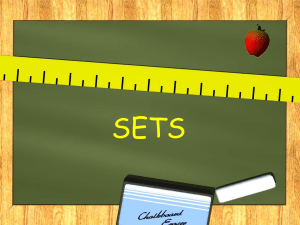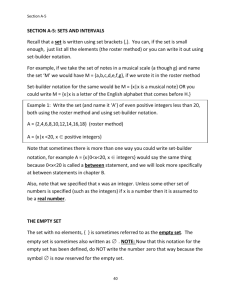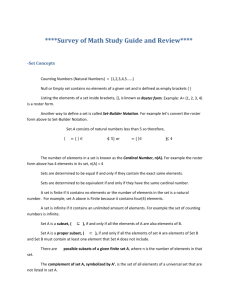Section2.1ma116notes..
advertisement
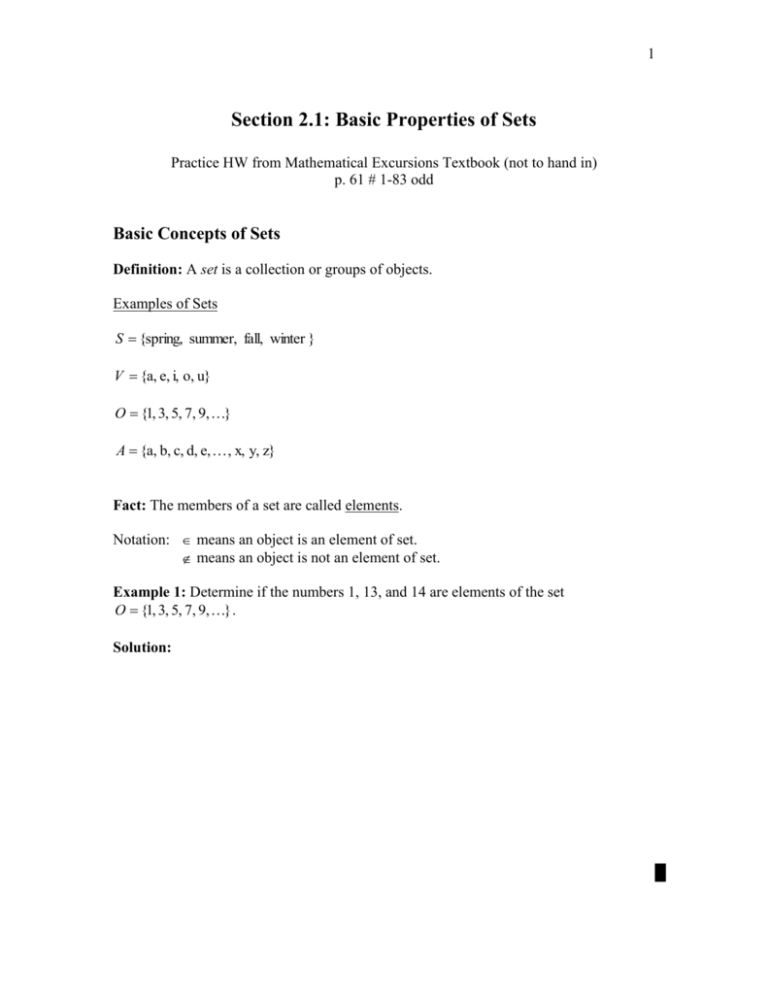
1
Section 2.1: Basic Properties of Sets
Practice HW from Mathematical Excursions Textbook (not to hand in)
p. 61 # 1-83 odd
Basic Concepts of Sets
Definition: A set is a collection or groups of objects.
Examples of Sets
S {spring, summer, fall, winter }
V {a, e, i, o, u}
O {1, 3, 5, 7, 9, }
A {a, b, c, d, e, , x, y, z}
Fact: The members of a set are called elements.
Notation: means an object is an element of set.
means an object is not an element of set.
Example 1: Determine if the numbers 1, 13, and 14 are elements of the set
O {1, 3, 5, 7, 9, } .
Solution:
█
2
Example 2: Determine if the letters b, m, and Y are elements of the
set A {a, b, c, d, e, , x, y, z} .
Solution:
█
Note: The empty set is the set with no elements.
Notation for empty set: { } or .
Basic Number Sets
Natural Numbers or Counting Numbers: N {1, 2, 3, 4, 5, 6, }
Whole Numbers: W {0, 1, 2, 3, 4, 5, 6, }
Integers: I { , 5, 4, 3, 2, 1, 0, 1, 2, 3, 4, 5, 6, }
Rational Numbers: Q = the set of all terminating numbers or repeating decimals, that is
p
the set of numbers of the form , where p and q are integers
q
and q 0 .
Irrational Numbers: J = the set of all numbers that are not a terminating number or
repeating decimal (not rational)
Real Numbers: R = the set of all rational numbers or irrational numbers
3
Ways of Describing Sets
1. Roster Form: When the elements of the set are written out inside a pair of braces.
The sets S {spring, summer, fall, winter } , V {a, e, i, o, u} , O {1, 3, 5, 7, 9, }
A {a, b, c, d, e, , x, y, z} are examples of sets in roster form.
Example 3: In roster form, write the set of people on the US dollar bills for the set of
bills less than or equal to $100.
Solution:
█
Example 4: In roster form, write the set of whole numbers less than 8
Solution:
█
Example 5: Write the set of integers x that satisfy x 5 3 in roster form.
Solution:
█
Example 6: Write the set of natural numbers x that satisfy x 5 3 in roster form.
Solution:
4
█
2. Verbal Description of Sets: describe set in words
Example 7: Write a description of the set {April, June, September, November}
Solution:
█
Example 8: Write a description of the set {x | x N and x 5}
Solution: Here, this set is read as the set of x such that x is a natural number (counting
number) that is less than 5. We can easily write the elements of this set, which in roster
form is { 1, 2, 3, 4}
█
3. Set-Builder Notation: Uses a short hand notation to describe sets, usually large ones
Notation is given by the form
{x | x }
(Read as the set of x such that x is …)
Example 9: Use set-builder notation to write the set {spring, summer, fall, winter } .
Solution:
5
█
Example 10: Use set-builder notation to write the set {10, 20, 30, , 90, 100} .
Solution: One solution could be
{x | x is an integer multiple of 10 greater th an or equal to 10 and less than or equal to 100}
█
Well Defined Set
A set is well defined is the elements of the sets are clearly defined, that is, if it is obvious
what elements belong it. If a set is well defined, then there should not be any confusion of
what the elements are in the set.
Examples of well defined sets: V {a, e, i, o, u}
O {1, 3, 5, 7, 9, }
Examples of sets that are not well defined: The set nice people,
K {3, 10, 100, 2, 1, 0, }
Cardinality of a Set
The cardinality of a finite set A, denoted by n ( A) , is the number of elements in that set.
Example 11: Determine cardinality of the set {a, e, i, o, u} .
Solution:
█
6
Example 12: Determine cardinality of the set B of countries that border the USA.
Solution:
█
Equal and Equivalent Sets
Set A is equal to set B, denoted by A B , if and only if A and B have the same elements,
regardless of order.
Set A is equivalent to set B, denoted by A ~ B , if and only if A and B have exactly the
same number of elements, regardless of order.
Note: The order that the elements of a set are listed does not matter. If the elements are
the same, the sets are equal. Also, each element of a set is listed just once. The elements
of a set in general are not repeated.
Example 13: Determine whether the sets {a, e, i, o, u} and {u, o, i, a, e} are equivalent,
equal or neither.
Solution:
█
Example 14: Determine whether the sets {1, 2, 3} and {4, 5, 6} are equivalent, equal or
neither.
Solution: Since the sets have the same number of elements (in this case 3), they are
equivalent sets. However, the elements are not the same. Thus, they are not equal.
█
7
Example 15: Determine whether the sets {1, 2, 3} and {4, 5} are equivalent, equal or
neither.
Solution:
█
